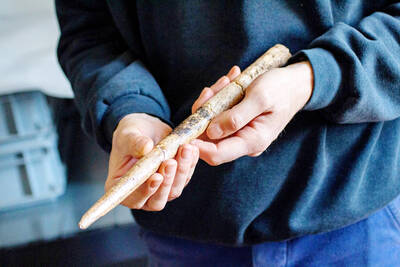Before the publication of her novel The Well of Loneliness in 1928, the writer Radclyffe Hall, a lesbian from an upper-class family in Bournemouth, southern England, warned her editor that the book would require a mammoth commitment from its publisher. "I have put my pen at the service of some of the most persecuted and misunderstood people in the world," she announced portentously.
"So far as I know nothing of the kind has ever been attempted before in fiction."
Hall's novel chronicles the life of Stephen Gordon, an English woman from an upper-class family, whose "sexual inversion" (as the likes of sexologist Havelock Ellis described homosexuality at that time) is apparent from an early age. It thus became the first novel ever to openly address lesbianism. Gordon falls for Mary Llewellyn, a woman she meets while serving as an ambulance driver in World War I, but the couple's happiness is ruined by their social rejection. A silent plea of "allow us the right to our existence" runs throughout the narrative, as the characters descend into despair, relieved only by copious amounts of cocaine and creme de menthe.
By modern standards the book is chaste; the only reference to lesbian sex is the line " … and that night they were not divided." But by portraying lesbianism as being as "natural" as heterosexuality, The Well of Loneliness was radical. Its publication provoked a major outcry, leading to an obscenity trial that concluded with the book's ban and an order that all copies should be pulped because it defended "unnatural practices between women." Public feeling was so strong that the editor of the London-based Sunday Express, James Douglas, wrote that he "would rather give a healthy boy or a healthy girl a phial of prussic acid than this novel."
Hall's book continued to be supported by well-known intellectuals such as Virginia Woolf and EM Forster, and was published in France and the US, where it sold steadily for decades. By 1943 it had been translated into 14 languages, but it remained banned in Britain until 1949, six years after Hall's death.
Today there is still much debate about The Well of Loneliness, which has been reissued for its 80th anniversary. While it has often been criticized for its gloomy outlook on homosexual life, and the author, Jeanette Winterson, refers to it as an "awful book," others see it as a literary classic. The writer Lee Lynch believes that no novel since "has been as great. It is beautifully written and constructed, with delightful prose. It is the standard-bearer; the lesbian The Grapes of Wrath."
Indeed, the novel remains a staple on the bookshelves of many a lesbian, and it has often been argued that it actively paved the way for the development of the lesbian novel - first in its pulp incarnation, then as a gritty counter-cultural genre, and latterly as a well-established and lucrative part of mainstream publishing. According to the crime writer Val McDermid, there are two distinct groupings within the broad category of "lesbian fiction." One is lesbian genre fiction - such as romance, mystery and science fiction, written by lesbians with predominantly lesbian characters and a gay female audience specifically in mind. Then there are books written by lesbians who depict a wider world and shine a critical light on it. These novels generally have lesbian characters, but they exist as part of a broader landscape, and the books have proved appealing to a huge range of readers. In fact, lesbian novels are now so accepted, successful and even respectable that their relevance to the lesbian community sometimes seems to have dimmed. At a time when lesbian characters are accepted with barely a blush by mainstream readers, do gay women really have any need of these literary role models?
Back in the 1950s, when lesbian pulp fiction first became popular, there is no doubt how important these characters were. Although the pulp novels were routinely shot through with negativity - lesbians being portrayed as mad, mannish neurotics - the books did, at the very least, validate the existence of an alternative sexuality for women. They featured lesbians in institutions, love triangles and being "saved" by straight men. Despite the fact that the protagonists rarely fared well, and the books had titles such as Women's Barracks and The Evil Friendship, they appealed to an entire generation of lesbian readers. The "rule" of pulp fiction was that characters could indulge in wild affairs with other women, but they then had to experience a downfall. That way, lesbian stories could be published, while still appearing to condemn unnatural practices.
A classic of the genre, albeit one with a happy ending, was Ann Bannon's Beebo Brinker. Brinker is a butch 17-year-old, fresh from a farm in her Wisconsin home town, who is banished by her family for wearing her brother's clothes in public. Arriving in Greenwich Village, she is soon befriended by a lonely gay man who teaches her the ropes of gay life. Together they explore the underground Village bars, where she finds the "love that smoulders in the shadows of the twilight world." The story ends with Brinker finding true love.
Another exception to the unhappy ending-rule was The Price of Salt by Patricia Highsmith, published in 1952 and written under the pseudonym Claire Morgan. The plot centers around the love affair between Therese, who works in a department store, and Carol, one of her customers. The relationship leads to Carol losing custody of her daughter, but the book's ending is optimistic, hinting that the women may stay together and find happiness.
The first contemporary novelist to come out as a lesbian was Maureen Duffy, author of the 1966 classic The Microcosm, which focuses on the community found within lesbian bars. Then as the gay and lesbian liberation movements gathered pace in the UK and US in the early 1970s, the genre began to change for the better.
The American novelist Rita Mae Brown, who lived with tennis star Martina Navratilova in the late 1970s, wrote the classic coming-out story Rubyfruit Jungle, published in 1973. This novel had a significant influence on lesbian literature. It swept away the figure of the closeted, lonely lesbian, replacing her with an out-and-proud character who pursued sex with lusty abandon, and believed that lesbianism was a positive choice rather than a condition of birth.
However, despite the changes for the better, few mainstream publishing companies wanted to publish lesbian fiction, which led to the emergence of a number of independent, lesbian-run publishing houses, such as Amazon and Naiad Press.
My favorite Naiad Press novel was Swashbuckler, written by Lynch and published in 1985. It is set in the 1950s and 1960s and follows 15 years in the life of New Yorker and butch dyke, Frenchy Tonneau. Where some lesbian authors tend to revert to stereotypical characters, Lynch's Frenchy is a lovable rascal. Her struggle to find acceptance in the context of gross homophobia is moving and funny, and paints a clear picture of how brave gay people had to be if they dared to come out in that era.
By the 1980s, many lesbian novels were picking up the popular themes of gay male literature, including descriptions of sado-masochism and other forms of sexual experimentation. There were also books that explored political issues such as racism and sexual violence. Say Jesus and Come to Me (1982), for instance, was written by one of the few African-American lesbian novelists of the time, Ann Allen Shockley. Her protagonist, Myrtle Black, is a closeted lesbian and evangelist who preaches sermons about the ills of discrimination. Hearing about the shooting of two young prostitutes, Black forms a coalition of women to challenge the racist, sexist sensibilities in her community. Although the book deals with serious issues, it features some hilarious and risque scenes. During one church service, for instance, Black gyrates wildly against a young, female member of her congregation while the oblivious gospel singers belt out their love for Jesus.
Then came the trend for lesbian detective and romance novels. In the 1980s, McDermid made her bones writing lesbian private detective novels, before moving into the mainstream, and turning to the serial-killer genre. In recent decades other lesbian writers, such as Ali Smith, Stella Duffy and Jackie Kay, have had huge success, and many readers probably don't give much thought to the sexuality of these writers. "These women are writing some of the best contemporary fiction," says McDermid, "and the fact that they are not ghettoized speaks to a general loosening up of British society."
One of Britain's most loved lesbian writers, Sarah Waters, author of the acclaimed Tipping the Velvet, believes that, today, so-called "lesbian fiction" appeals to a wide spectrum of people, but that "what gives it a common identity is the extra political and emotional charge it has for its core audience, who still struggle to see honest and fair representations of their lives in mainstream culture. As long as this charge continues to exist, the 'lesbian' label will remain important."

Taiwan Power Co (Taipower, 台電) and the New Taipei City Government in May last year agreed to allow the activation of a spent fuel storage facility for the Jinshan Nuclear Power Plant in Shihmen District (石門). The deal ended eleven years of legal wrangling. According to the Taipower announcement, the city government engaged in repeated delays, failing to approve water and soil conservation plans. Taipower said at the time that plans for another dry storage facility for the Guosheng Nuclear Power Plant in New Taipei City’s Wanli District (萬里) remained stuck in legal limbo. Later that year an agreement was reached

What does the Taiwan People’s Party (TPP) in the Huang Kuo-chang (黃國昌) era stand for? What sets it apart from their allies, the Chinese Nationalist Party (KMT)? With some shifts in tone and emphasis, the KMT’s stances have not changed significantly since the late 2000s and the era of former president Ma Ying-jeou (馬英九). The Democratic Progressive Party’s (DPP) current platform formed in the mid-2010s under the guidance of Tsai Ing-wen (蔡英文), and current President William Lai (賴清德) campaigned on continuity. Though their ideological stances may be a bit stale, they have the advantage of being broadly understood by the voters.

In a high-rise office building in Taipei’s government district, the primary agency for maintaining links to Thailand’s 108 Yunnan villages — which are home to a population of around 200,000 descendants of the Chinese Nationalist Party (KMT) armies stranded in Thailand following the Chinese Civil War — is the Overseas Community Affairs Council (OCAC). Established in China in 1926, the OCAC was born of a mandate to support Chinese education, culture and economic development in far flung Chinese diaspora communities, which, especially in southeast Asia, had underwritten the military insurgencies against the Qing Dynasty that led to the founding of

Artifacts found at archeological sites in France and Spain along the Bay of Biscay shoreline show that humans have been crafting tools from whale bones since more than 20,000 years ago, illustrating anew the resourcefulness of prehistoric people. The tools, primarily hunting implements such as projectile points, were fashioned from the bones of at least five species of large whales, the researchers said. Bones from sperm whales were the most abundant, followed by fin whales, gray whales, right or bowhead whales — two species indistinguishable with the analytical method used in the study — and blue whales. With seafaring capabilities by humans